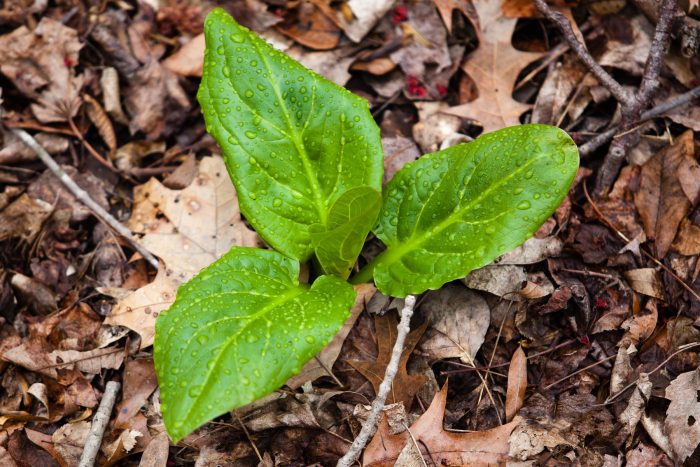Eastern Skunk Cabbage
Symplocarpus foetidus
Skunk cabbage is an early-blooming plant native to the forests, woodlands and swamps of the eastern United States.
This section shows one large critter image at a time. Use the thumbnails that follow to select a specific image to display here.

This gallery contains a grid of small thumbnails. Selecting a thumbnail will change the main image in the preceding section.
Appearance
The skunk cabbage emerges in early spring or late winter depending on the region it's growing in. The first thing to appear is the spathe. This is a single four to six-inch leaf-like structure which is often maroon with green splotches. The spathe covers the spadix, a knob-like spike in the middle of the plant. Petalless flowers can be seen on the spadix.
Once the plant has been pollinated, the spathe will die and bright green leaves will emerge in a rosette. The leaves can grow to be one foot wide and three feet long. By the time the tree canopy fills in, the green leaves will die back. The plant will remain dormant until the following spring or late winter.
Predators
Snails, slugs, bears and snapping turtles will occasionally eat the leaves of the skunk cabbage.
Reproduction and life cycle
In early spring or late winter, the skunk cabbage produces dozens of tiny flowers. The stigma, the female part of the plant is developed first. Once it has been pollinated,the male part of the plant, the stamen, will develop. This prevents the plant from pollinating itself and increases genetic diversity.
Throughout the spring the spadix will develop seeds. The spadix will mature and fall apart to disperse seeds by the end of summer.
Did you know?
- Skunk cabbage plants have enormous root systems that allow the plants to stay dormant for a large part of the year and emerge with explosive growth.
- The skunk cabbage creates its own heat through a process known as thermogenesis. The temperature within the spathe is often 20 degrees warmer than the surrounding air temperature. This allows the plant to emerge even when there is snow on the ground.
- Skunk cabbage leaves contain calcium oxalate which can cause severe skin irritation. The plant has only few predators including snails, slugs, bears and snapping turtles. Most will only eat this plant in extreme situations.
- The skunk cabbage gets its name from the foul smell it produces when it is blooming. The smell helps lure insects to the flowers to increase pollination.
Sources and additional information
- Plant of the Month December 2020: Skunk Cabbage – Northern Neck Native Plant Society
- Skunk Cabbage – National Wildlife Federation
- Skunk Cabbage – Penn State University
